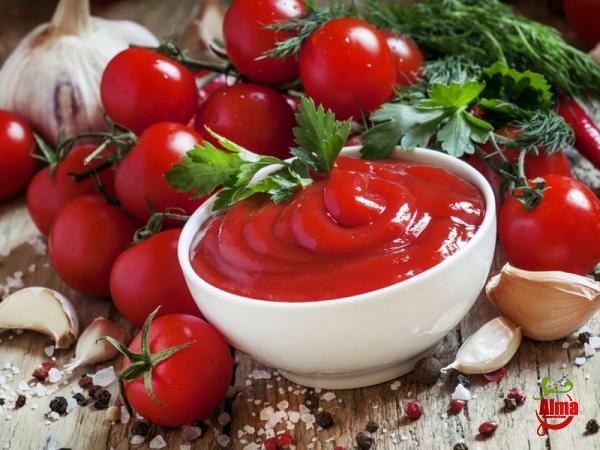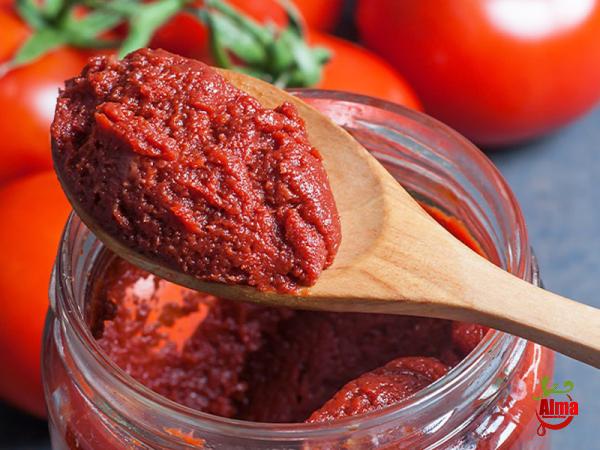Understanding the Tomato Paste Ingredients Label: A Comprehensive Overview Introduction: The ingredients label is a vital tool for consumers to understand the various components of a product and make informed choices about what they consume. In this summary, we will dive into the tomato paste ingredients label, exploring its different elements and deciphering the information it provides. We will delve into common ingredients found in tomato paste, their purpose, and potential health considerations associated with their consumption. Tomato Paste Ingredients: 1. Tomato Concentrate: Tomato concentrate is typically the first ingredient listed in tomato paste. It is made by cooking down ripe tomatoes, removing the seeds, and reducing the liquid content to form a concentrated form of tomato flavor. Tomato concentrate is a critical component of tomato paste, providing the rich and intense taste associated with this product. 2. Water: Water is often added to tomato paste to achieve the desired consistency. It helps create a smooth and spreadable texture, making the tomato paste easier to use in various recipes. The amount of water added can vary depending on the brand and desired consistency of the paste. 3. Salt: Salt is a common ingredient in tomato paste, serving as a flavor enhancer. It helps bring out the natural sweetness of the tomatoes and balances the acidity. However, it is important to note that the sodium content can be high in tomato paste, so individuals on a low-sodium diet should be mindful of their consumption. 4. Citric Acid: Citric acid, derived from citrus fruits, is often added to tomato paste as an acidity regulator. It helps balance the pH level, ensuring the tomato paste remains safe for consumption and extends its shelf life. 5. Ascorbic Acid (Vitamin C): Ascorbic acid, also known as vitamin C, is sometimes added to tomato paste as a preservative. It helps slow down the oxidation process and prevents the browning of the tomato paste. Additionally, vitamin C has antioxidant properties and may provide some health benefits. 6. Calcium Chloride: Calcium chloride is an additive that is occasionally used in tomato paste production. It helps maintain the texture and firmness of the tomatoes during processing and prevents them from becoming too mushy.

tomato paste
 7. Natural Flavors: The term “natural flavors” on a tomato paste label refers to substances that are derived from natural sources, such as fruits, vegetables, or spices, to enhance the taste. It is important to note that the specific ingredients used are not always listed individually, but they must meet certain regulatory standards to be classified as “natural flavors.” Additional Considerations: 1. Allergens: While tomato paste is generally free from common allergens such as gluten, dairy, and eggs, cross-contamination during processing or packaging may still occur. Individuals with specific allergies should always check the label for allergen warnings or seek out products specifically labeled as allergen-free. 2. Artificial Additives: In some cases, tomato paste may contain artificial additives such as artificial colors, artificial flavors, or preservatives. These additives are used to enhance the appearance, taste, or shelf life of the product. While they are generally recognized as safe for consumption, some individuals prefer to avoid artificial additives due to personal preferences or sensitivities. 3. Organic and Non-GMO Options: Consumers increasingly prioritize organic and non-GMO (genetically modified organism) products. Tomato paste labeled as “organic” indicates that it is made from tomatoes grown without the use of synthetic pesticides or fertilizers. Similarly, “non-GMO” tomato paste is made from tomatoes that have not been genetically modified.
7. Natural Flavors: The term “natural flavors” on a tomato paste label refers to substances that are derived from natural sources, such as fruits, vegetables, or spices, to enhance the taste. It is important to note that the specific ingredients used are not always listed individually, but they must meet certain regulatory standards to be classified as “natural flavors.” Additional Considerations: 1. Allergens: While tomato paste is generally free from common allergens such as gluten, dairy, and eggs, cross-contamination during processing or packaging may still occur. Individuals with specific allergies should always check the label for allergen warnings or seek out products specifically labeled as allergen-free. 2. Artificial Additives: In some cases, tomato paste may contain artificial additives such as artificial colors, artificial flavors, or preservatives. These additives are used to enhance the appearance, taste, or shelf life of the product. While they are generally recognized as safe for consumption, some individuals prefer to avoid artificial additives due to personal preferences or sensitivities. 3. Organic and Non-GMO Options: Consumers increasingly prioritize organic and non-GMO (genetically modified organism) products. Tomato paste labeled as “organic” indicates that it is made from tomatoes grown without the use of synthetic pesticides or fertilizers. Similarly, “non-GMO” tomato paste is made from tomatoes that have not been genetically modified.
Specifications of tomato paste
 Conclusion: Understanding the tomato paste ingredients label empowers consumers to make informed choices about the products they consume. By examining the various components of tomato paste, such as tomato concentrate, water, salt, citric acid, ascorbic acid, calcium chloride, and natural flavors, consumers gain insight into the nutritional value and potential health considerations associated with these ingredients. Additionally, considering allergens, artificial additives, and the availability of organic and non-GMO options helps individuals make choices aligned with their personal preferences and dietary needs. The tomato paste ingredients label is a valuable tool for promoting transparency and aiding consumers in making well-informed decisions about the products they bring into their kitchens.Title: Understanding the Tomato Paste Ingredients Label: A Comprehensive Overview Introduction: The ingredients label is a vital tool for consumers to understand the various components of a product and make informed choices about what they consume. In this article, we will delve deeper into the tomato paste ingredients label, exploring its different elements and deciphering the information it provides. We will examine the common ingredients found in tomato paste, their purpose, and potential health considerations associated with their consumption. 1. Tomato Concentrate: Tomato concentrate is typically the main ingredient listed in tomato paste. It is made by cooking down ripe tomatoes, removing the seeds, and reducing the liquid to form a concentrated source of tomato flavor. The process of making tomato concentrate involves intensifying the natural flavors of the tomatoes. This gives tomato paste its distinct and concentrated taste. 2. Water: Water is often added to tomato paste to achieve the desired consistency. It helps create a smooth and spreadable texture, making the tomato paste easier to use in various recipes. The amount of water added can vary depending on the brand and desired thickness of the paste. However, it is important to note that excessive water content can lower the overall tomato flavor. 3. Salt: Salt is a common ingredient in tomato paste, serving as a flavor enhancer. It helps bring out the natural sweetness of the tomatoes and balances the acidity. The addition of salt provides a boost to the overall taste profile of the tomato paste. However, individuals on a low-sodium diet should be mindful of their consumption, as tomato paste can be a significant source of sodium. 4. Citric Acid: Citric acid, derived from citrus fruits, is often added to tomato paste as an acidity regulator. It helps balance the pH level, ensuring the tomato paste remains safe for consumption and extends its shelf life. Citric acid also enhances the tartness of the tomatoes, giving the tomato paste a desirable tangy flavor. 5. Ascorbic Acid (Vitamin C): Ascorbic acid, also known as vitamin C, is sometimes added to tomato paste as a preservative. It helps slow down the oxidation process and prevents the browning of the tomato paste over time. Vitamin C also acts as an antioxidant, which may provide some health benefits. However, it is important to note that the vitamin C content in tomato paste is relatively low compared to fresh tomatoes.
Conclusion: Understanding the tomato paste ingredients label empowers consumers to make informed choices about the products they consume. By examining the various components of tomato paste, such as tomato concentrate, water, salt, citric acid, ascorbic acid, calcium chloride, and natural flavors, consumers gain insight into the nutritional value and potential health considerations associated with these ingredients. Additionally, considering allergens, artificial additives, and the availability of organic and non-GMO options helps individuals make choices aligned with their personal preferences and dietary needs. The tomato paste ingredients label is a valuable tool for promoting transparency and aiding consumers in making well-informed decisions about the products they bring into their kitchens.Title: Understanding the Tomato Paste Ingredients Label: A Comprehensive Overview Introduction: The ingredients label is a vital tool for consumers to understand the various components of a product and make informed choices about what they consume. In this article, we will delve deeper into the tomato paste ingredients label, exploring its different elements and deciphering the information it provides. We will examine the common ingredients found in tomato paste, their purpose, and potential health considerations associated with their consumption. 1. Tomato Concentrate: Tomato concentrate is typically the main ingredient listed in tomato paste. It is made by cooking down ripe tomatoes, removing the seeds, and reducing the liquid to form a concentrated source of tomato flavor. The process of making tomato concentrate involves intensifying the natural flavors of the tomatoes. This gives tomato paste its distinct and concentrated taste. 2. Water: Water is often added to tomato paste to achieve the desired consistency. It helps create a smooth and spreadable texture, making the tomato paste easier to use in various recipes. The amount of water added can vary depending on the brand and desired thickness of the paste. However, it is important to note that excessive water content can lower the overall tomato flavor. 3. Salt: Salt is a common ingredient in tomato paste, serving as a flavor enhancer. It helps bring out the natural sweetness of the tomatoes and balances the acidity. The addition of salt provides a boost to the overall taste profile of the tomato paste. However, individuals on a low-sodium diet should be mindful of their consumption, as tomato paste can be a significant source of sodium. 4. Citric Acid: Citric acid, derived from citrus fruits, is often added to tomato paste as an acidity regulator. It helps balance the pH level, ensuring the tomato paste remains safe for consumption and extends its shelf life. Citric acid also enhances the tartness of the tomatoes, giving the tomato paste a desirable tangy flavor. 5. Ascorbic Acid (Vitamin C): Ascorbic acid, also known as vitamin C, is sometimes added to tomato paste as a preservative. It helps slow down the oxidation process and prevents the browning of the tomato paste over time. Vitamin C also acts as an antioxidant, which may provide some health benefits. However, it is important to note that the vitamin C content in tomato paste is relatively low compared to fresh tomatoes.
buy tomato paste
 6. Calcium Chloride: Calcium chloride is an additive that is occasionally used in tomato paste production. It helps maintain the texture and firmness of the tomatoes during processing and prevents them from becoming too mushy. Calcium chloride is a calcium salt known for its ability to strengthen pectin, a substance that contributes to the structural integrity of the tomato cells. Its use in tomato paste ensures a desirable consistency and texture. 7. Natural Flavors: The term “natural flavors” on a tomato paste label refers to substances that are derived from natural sources, such as fruits, vegetables, or spices, to enhance the taste. It is important to note that the specific ingredients used as natural flavors are not always listed individually, but they must meet certain regulatory standards to be classified as “natural flavors.” These natural flavors may be added to enhance and complement the tomato taste, providing a more rounded and complex flavor profile. Additional Considerations: 1. Allergens: While tomato paste is generally free from common allergens such as gluten, dairy, and eggs, cross-contamination during processing or packaging may still occur. Individuals with specific allergies or sensitivities should always read the label for allergen warnings or seek out products specifically labeled as allergen-free. 2. Artificial Additives: In some cases, tomato paste may contain artificial additives such as artificial colors, artificial flavors, or preservatives. These additives are used to enhance the appearance, taste, or shelf life of the product. While they are generally recognized as safe for consumption, some individuals prefer to avoid artificial additives due to personal preferences or sensitivities. Checking the ingredient label can help identify if any artificial additives are present. 3. Organic and Non-GMO Options: As consumers increasingly prioritize organic and non-GMO (genetically modified organism) products, tomato paste options meeting these criteria are becoming more readily available. “Organic” tomato paste indicates that it is made from tomatoes grown without the use of synthetic pesticides or fertilizers. Similarly, “non-GMO” tomato paste is made from tomatoes that have not been genetically modified. These options cater to those who prefer products aligning with their personal values and dietary choices. Conclusion: Understanding the tomato paste ingredients label empowers consumers to make informed choices about the products they consume. By examining the various components of tomato paste, such as tomato concentrate, water, salt, citric acid, ascorbic acid, calcium chloride, and natural flavors, consumers gain insight into the nutritional value and potential health considerations associated with these ingredients. Additionally, considering allergens, artificial additives, and the availability of organic and non-GMO options helps individuals make choices aligned with their personal preferences and dietary needs. The tomato paste ingredients label is a valuable tool for promoting transparency and aiding consumers in making well-informed decisions about the products they bring into their kitchens.
6. Calcium Chloride: Calcium chloride is an additive that is occasionally used in tomato paste production. It helps maintain the texture and firmness of the tomatoes during processing and prevents them from becoming too mushy. Calcium chloride is a calcium salt known for its ability to strengthen pectin, a substance that contributes to the structural integrity of the tomato cells. Its use in tomato paste ensures a desirable consistency and texture. 7. Natural Flavors: The term “natural flavors” on a tomato paste label refers to substances that are derived from natural sources, such as fruits, vegetables, or spices, to enhance the taste. It is important to note that the specific ingredients used as natural flavors are not always listed individually, but they must meet certain regulatory standards to be classified as “natural flavors.” These natural flavors may be added to enhance and complement the tomato taste, providing a more rounded and complex flavor profile. Additional Considerations: 1. Allergens: While tomato paste is generally free from common allergens such as gluten, dairy, and eggs, cross-contamination during processing or packaging may still occur. Individuals with specific allergies or sensitivities should always read the label for allergen warnings or seek out products specifically labeled as allergen-free. 2. Artificial Additives: In some cases, tomato paste may contain artificial additives such as artificial colors, artificial flavors, or preservatives. These additives are used to enhance the appearance, taste, or shelf life of the product. While they are generally recognized as safe for consumption, some individuals prefer to avoid artificial additives due to personal preferences or sensitivities. Checking the ingredient label can help identify if any artificial additives are present. 3. Organic and Non-GMO Options: As consumers increasingly prioritize organic and non-GMO (genetically modified organism) products, tomato paste options meeting these criteria are becoming more readily available. “Organic” tomato paste indicates that it is made from tomatoes grown without the use of synthetic pesticides or fertilizers. Similarly, “non-GMO” tomato paste is made from tomatoes that have not been genetically modified. These options cater to those who prefer products aligning with their personal values and dietary choices. Conclusion: Understanding the tomato paste ingredients label empowers consumers to make informed choices about the products they consume. By examining the various components of tomato paste, such as tomato concentrate, water, salt, citric acid, ascorbic acid, calcium chloride, and natural flavors, consumers gain insight into the nutritional value and potential health considerations associated with these ingredients. Additionally, considering allergens, artificial additives, and the availability of organic and non-GMO options helps individuals make choices aligned with their personal preferences and dietary needs. The tomato paste ingredients label is a valuable tool for promoting transparency and aiding consumers in making well-informed decisions about the products they bring into their kitchens.









Your comment submitted.